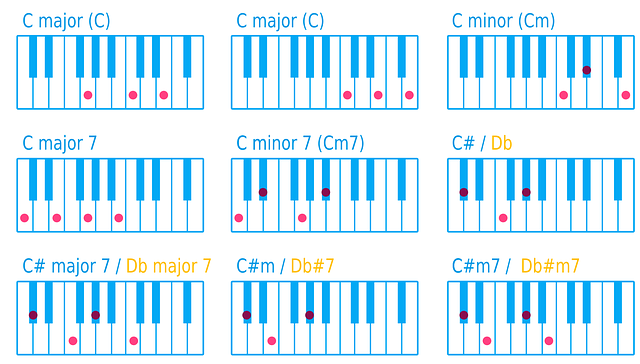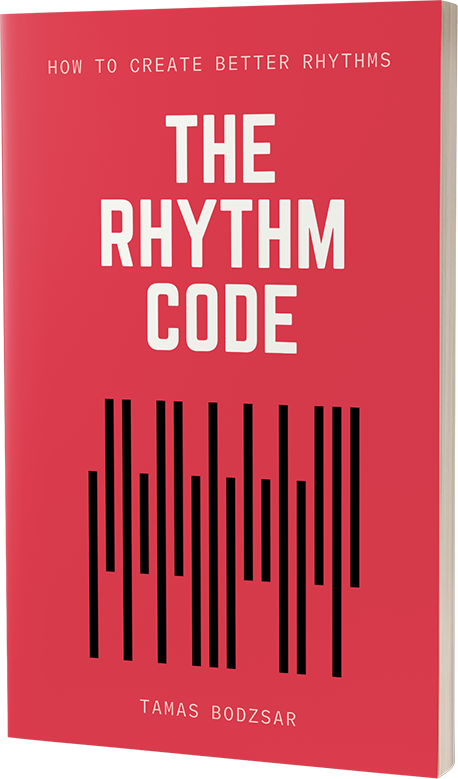
The absolutely best way to learn songwriting is by writing down songs for the purpose of analyzing them. In order to be able to do that, we need to recognize the chords just by listening to the music.
This could look very hard if you have never transcribed music before, but since I’m transcribing music for more than 20 years now, I can tell you exactly how you can learn to do it very fast.
There are millions of sheet music, chords, and guitar tabs out there, but unfortunately 80% of those are totally inaccurate, so we can’t rely on them. If you find the lyrics of a song with only chord symbols, you can be 99% sure that the chords are wrong.
So here is how you can identify the chords of a song by ear, either because you want to write it down, or maybe because you want to play the song.
Ear training
Most people think that you need talent to recognize chords by ear, and they believe that you need to born with this talent. But I highly disagree with this. It’s true that some people learn this much faster than others, but I truly believe that literally anyone can learn to recognize chords by ear. You just need to learn the right method.
Do you recognize songs on the radio? If the answer is yes, then you can learn how to recognize chords. Because it’s exactly the same. But let’s say I play a bunch of song you have never heard before. Would you recognize the songs? No, you wouldn’t. Why is that? It’s because you didn’t learn how they sound. You would hear that they are different from each other, but you wouldn’t recognize the songs.
So the same applies to chords. You just need to learn how they sound to be able to recognize them. And you can learn that in less than 30 days.
First, you need an ear training app like EarMaster. Set the app in a way that it will play only two chords for you randomly. For example, let’s start with a major and a minor triad. Now the app will randomly play those two chords, and you need to identify them.
Once you can identify those two chords with 100% accuracy, you can add ONE more chord, for example, a diminished chord. Now the app will play those three chords randomly, and you need to recognize them. This will be easy, since you already know the first two chords, so if you are not sure about it, then it’s probably the diminished chord.
Once you recognize the three chords, you can make another step further, and add an augmented chord. And so on… You can make the same steps with the seventh chords too. If you do this only a daily basis for a few weeks, you will recognize all chords in a matter of a second.
Start with something simple
The next step is to recognize the chords from actual songs. It will be much difficult at first, because with the ear training software you only hear the sterile chords, however, in an actual song there are many other instruments (and many other chords) playing at the same time. That’s why you need to start with something simple.
It has to be something slow with only a few chords, and not many instruments. If there are too many instruments in a song, it’s much harder to hear the different instruments.
Even if you are a jazz musician, it’s always a good idea to start with something really simple – like a pop song you hear on the radio.
It’s important to know that you don’t need to write down the chords in real time. You can play the song until the first chord, and then STOP the recording, and try to figure out the chords.
You can use a musical instrument to play back the notes or chords you hear.
Identify the key
This is probably the easiest step for everyone. Everyone can hear the tonal center of a song (unless there are many exotic chords or modulation in the music).
The tonal center is the “home”, it’s the tonic. For example the note C in the key of C major. So try to identify the tonal center, and figure out if this is a major or a minor key.
Play the song for a while and listen to the melody. The easiest way to find the tonal center is by listening to the melody, not the chords!
So listen to the melody for a while and then stop the recording, and try to SING the tonal center, the “arrival”.
When you found the “home”, and you identified if it’s a major or a minor key, you can try to play the scale on an instrument. About 95% of the songs are in the regular major key.
When you have the key, then you know what chords will most likely used in the song. For example, most songs probably won’t use the VIIdim chord (like Bdim in the key of C major). These are the most frequently use chords in the key of C major:
C (C – E – G)
Dm (D – F – A)
Em (E – G – B)
F (F – A – C)
G (G – B – D)
Am (A – C – E)
You already narrowed it down to 6 possible chords.
Identify the bass
“It’s not a C chord unless the bass player says so” – Sting
When I was 16 years old (about 21 years ago), I was sitting at my piano, and listening to the radio. Actually, at that time, I needed to record the song from the radio with a cassette tape recorder. So I played the song from the cassette, and tried to identify the chords. That was the first time I was trying to recognize chords by ear.
I figured out that the chord was C – E – G – B, so it’s a Cmaj7 chord! I was wrong. I wasn’t aware of the bass. The bass was playing the note A. So it was not a Cmaj7 chord. It was an Am9 chord (A – C – E – G – B)
As Sting said: “It’s not a C chord unless the bass player says so”. And he is right. You need to be aware of what the bass plays, because it determines the chord.
In fact, I realized later that it’s much easier to identify a chord if you know what the bass plays.
So try to identify the bass first, and that will help a lot. Sometimes it’s easier to hear the bass because the upper registers are very busy.
Take these steps:
1. Play the first chord of the song, and then STOP the recording.
2. Try to SING or hum the bass note. Still can’t find it? Go back and play the first note again, but ONLY the first note!
3. When you can sing the bass note (obviously one or two octave higher), sing it a few times to isolate this note in your head.
4. Now try to find this note on an instrument.
If you have the key, and you have the bass notes, you can already try to “guess” the chords. If the song is in the key of C major, and the bass is playing the note A, then it’s most likely an Am or Am7 chord. Because most of the time the bass plays the root note!
However, this is where you need to really listen. Because if the bass plays the note B, then the chord can be a G/B (B – D – G) and NOT a Bdim chord. (In fact, in the key of C major, they most likely use the chord G/B and not a Bdim). Those two chords have very different sounds, so this is why you need to train your ear to hear the difference between them.
If you done your work with the ear training, then you won’t have a problem identifying the chords.
Slow it down
If the song is too fast, or the instrumentation is too busy, there are tools to slow down the recording, which makes it easier to hear the notes or chords. Transcribe is a perfect tool for this.
I even use Transcribe for practicing too if I want to play together with the original recording. For example, if I want to learn a new song, I can slow down the recording to 75% and I can play together with this slower version. Then I set it to 76%… and then 77%… until I know the song at 100% tempo. Great tool.
Look for another version of the song
This is a really useful “hack” I share with you now. Sometimes it’s harder to hear the chords or the bass, maybe because there are too many instruments playing at once or maybe the chords disappear in the mix, and there is not much accent on the chords. In that case, you can try to find a different version of the song.
For example, you probably start to listen to the original studio version of the song. But you can try to find live versions of the song on Youtube. The benefit of this is that you will hear a totally different mix on a live concert version. Maybe the guitar or the piano disappears on the studio version, but you will hear them crystal clear on the live version.
Not long ago, I was analyzing the song The Scientist by Coldplay. On the original studio recording they mixed the song in a way that the chords are not perfectly clear to hear. But if you listen to the live concert version of this song on Youtube, you will hear the piano chords very clearly.
In Summary
It may seem hard to identify the chords if you don’t know how to start, but actually it’s very easy if you know the right methods and also your ear so you can recognize them, like you recognize any song you already know.
1. Learn to recognize the different chords. (Train your ear)
2. Start with a simple song: slow tempo, few chords, few instruments.
3. Identify the key. (By finding the tonic, which is the “home”.)
4. Identify the bass. Because it mostly plays the root note.
5. Slow it down with a software, so it’s easier to recognize the chords and the bass.
6. If you don’t hear a chord, try to find a different version of the song, like a live concert version.
The secret pattern behind successful songs
Get the eBook for $4.99

